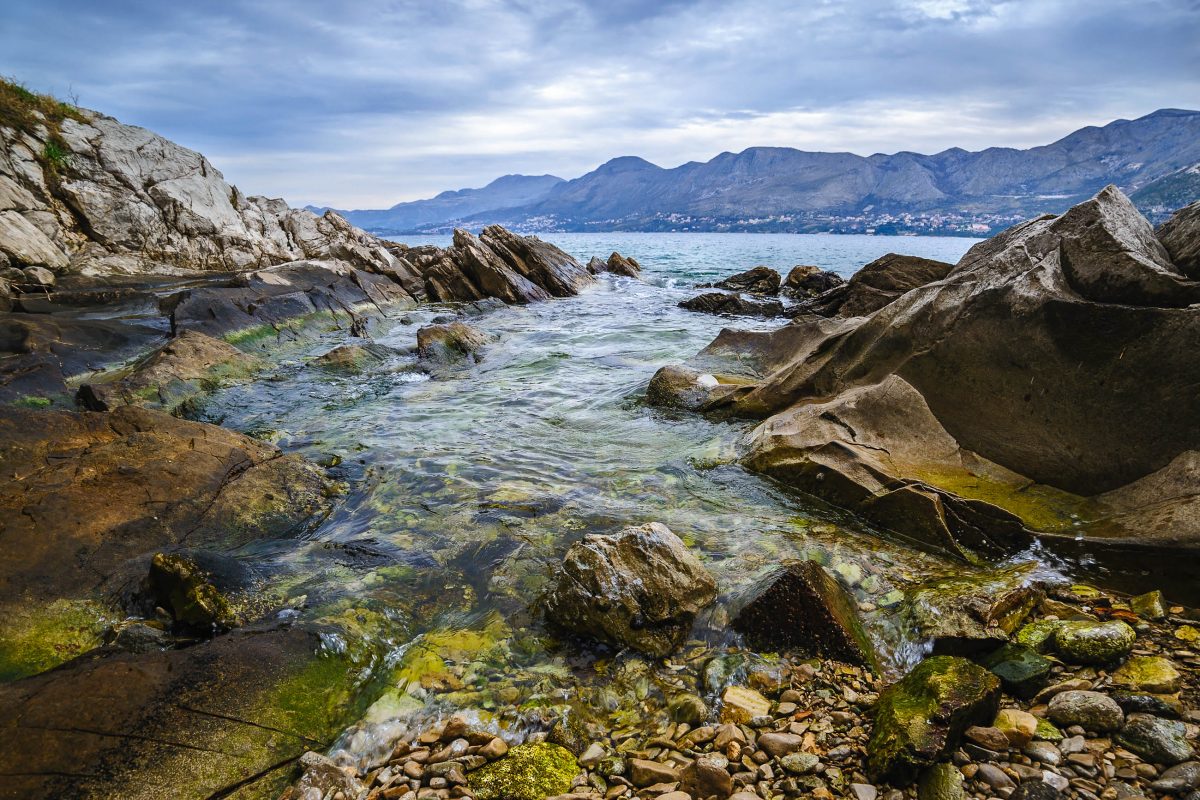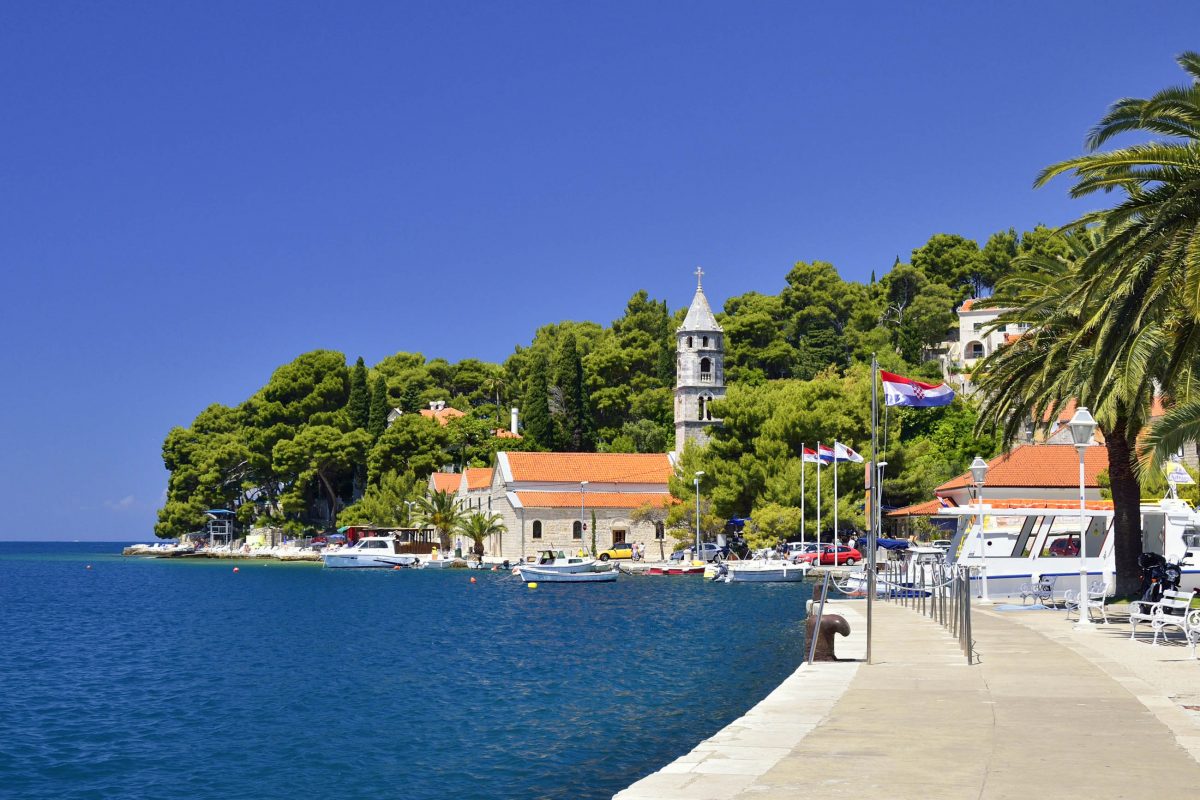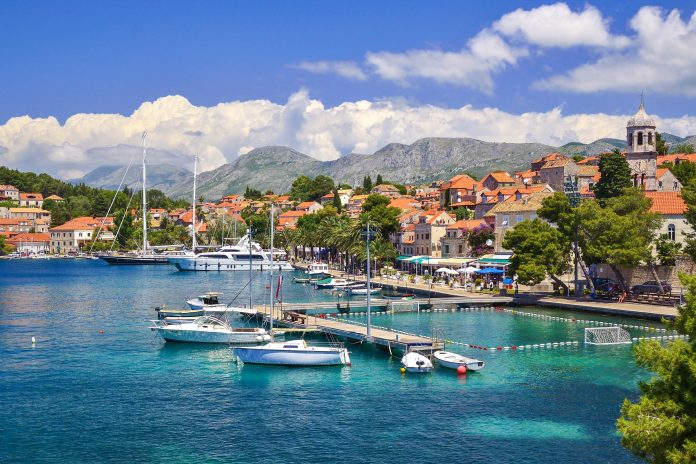Der zauberhafte Urlaubsort Cavtat im äußersten Süden von Dalmatien bietet perfekte Badebedingungen und einzigartigen Tauchgründe. Mit historischen Sehenswürdigkeiten verstecken sich auch an Land zahlreiche Schätze vergangener Zeiten und ein herrliches Naturparadies.
Rund 20km südlich der UNESCO-Welterbestadt Dubrovnik liegt an der Küste Kroatiens mit dem malerischen Cavtat einer der schönsten Badeorte Dalmatiens. Mit seiner Nähe zum Flughafen von Dubrovnik (nur 5km entfernt) ist Cavtat sowohl über Land, als auch über das Meer und aus der Luft gut zu erreichen.
Als „Schlusslicht“ Richtung Süden gibt die kroatische Küste scheinbar noch einmal alles an Schönheit her, was sie zu bieten hat. Die Altstadt von Cavtat erstreckt sich nordwestlich des örtlichen Hafens über die bewaldete Halbinsel Rat und lädt in ihren verwinkelten Gassen zur Entdeckung zahlreicher kulturhistorischer Sehenswürdigkeiten.
Inhaltsverzeichnis
Strände von Cavtat
Cavtat ist vor allem als perfekte Destination für Badeurlaub in Kroatien bekannt. Die Halbinsel der Altstadt wird auf einer Länge von rund 7km von seichten Kies- und Felsbuchten umgeben.
- Aufgrund seiner ausgezeichneten Infrastruktur und der Nähe zum Hafen ist der Stadtstrand Ispod Gospe als Familienstrand besonders beliebt.
- Nicht weit davon entfernt liegt die türkisblaue Kiesel-Bucht Tiha, die durch Bäume von den Straßen abgeschirmt zum Sonnenbaden und Relaxen einlädt.
- Noch mehr Wald gibt es am Strand Kamen mali auf der Halbinsel Rat, auf dem das klare Wasser in den Felsbuchten ebenfalls zum Schnorcheln einlädt.
- Am Felsstrand Kljucice sorgen betonierte Flächen für mehr Bequemlichkeit, ein Lager aufzuschlagen.
- Auf der Halbinsel Sustjepan ist die FKK-Strand von Cavtat zu finden.
Tipp: Hüllenloses Baden ist übrigens auch auf der vorgelagerten Insel Supetar möglich, die als kleines FKK-Paradies von Cavtat bekannt ist.
Elafitische Inseln
Auch die über 30 Elafitischen Inseln bei Dubrovnik bieten Badevergnügen vom Feinsten. Vor allem die drei größten, Sipan, Kolocep und die belebtere Insel Lopud, locken mit dichter Vegetation, einsamen Felsbuchten und malerischen Häfen.
Tauchen und Schnorcheln in Cavtat

Unter Wasser hält Cavtat für Taucher und Schnorchler ebenfalls einige Sehenswürdigkeiten bereit. Als einer der größten Amphoren-Fundorte des Mittelmeers gibt es entlang der Küste von Cavtat neben einer faszinierenden Unterwasserwelt auch tönerne Vermächtnisse der Antike zu entdecken. Nachdem es um die Ortschaft kaum Sandbänke gibt, erfreuen sich Taucher und Schnorchler in Cavtat an optimaler Sicht unter Wasser.
Sehenswürdigkeiten von Cavtat
Die Mischung aus mildem Klima, üppiger Vegetation, schmucken Ferienhäusern und sehenswerter Altstadt mit Bauten aus der Zeit, als Dubrovnik noch Republik war, macht Cavtat zu einem beliebten Ferienziel für Urlauber im Süden von Kroatien. In zahlreichen Restaurants, Bars und Cafés sorgen kühle Drinks und regionale Spezialitäten nach ausgiebigem Sightseeing für Gaumenfreuden.
Den mittelalterlichen Kern, der sich entlang des malerischen Yachthafens zwischen den beiden Halbinseln Sustjepan und Rat erstreckt, erkundet man am besten zu Fuß. Ein Übersichtsplan ist in der Touristeninformation von Cavtat (Zidine 6) erhältlich, die auch als perfekter Ausgangspunkt für einen Rundgang durch Cavtat fungiert.
St. Nikolaus-Kirche
Fast direkt an der Uferpromenade thront die Kirche des Hl. Nikolaus aus dem Jahr 1732. Die barocke Innenausstattung wird von Gemälden von heimischen Maler Vlaho Bukovac und Carmelo Reggio Palermitano aus Dubrovnik geschmückt. Gleich neben dem Pfarrhof ist seit 1952 die Pinakothek der Pfarrkirche zu finden, die wertvolle Plastiken, Malereien und Reliefs beherbergt.
Rektorenpalast und Stadtmuseum
Die nächste Sehenswürdigkeit an der Uferpromenade entlang ist der Rektorenpalast, der heute als Museum fungiert. Über 35.000 Exponate aus der Sammlung des damals weltberühmten Gelehrten Baltazar Bogišić aus dem 19. bzw. 20. Jahrhundert sind hier zu besichtigen.
Die Ausstellung umfasst kostbare Bücher, wertvolle historische Dokumente, Drucke und Grafiken, sowie Waffen und Münzen der Republik Dubrovnik. Zu den Highlights der Sammlung gehören das Lapidarium mit Fundstücken aus der Antike und das Gemälde „Cavtater Karneval“ von Vlaho Bukovac.
Franziskanerkloster und Kirche Maria Schnee

An den Anlegestellen vorbei folgt das Franziskanerkloster mit der Kirche Maria Schnee. Die Renaissance-Kirche stammt aus dem 15. Jahrhundert, am Kloster sind auch gotische Elemente zu finden. Sehenswert sind der prächtige Flügelaltar der Seitenkapelle, der 1510 vom Malermeister Vicko Lovrin Dobričević geschaffen wurde, und der meisterhafte Renaissance-Kreuzgang des Klosters.
Friedhof am Rochusberg und Mausoleum der Familie Račić
An der Spitze der Altstadthalbinsel, umgeben von einem lauschigen Wäldchen liegt auf dem Friedhof von Cavtat die letzte Ruhestätte der Familie Račić. In weißem Marmor gehauen symbolisiert die mit Engeln geschmückte Gruft die drei Lebensphasen Geburt, Schicksal und Tod.
Das Mausoleum gilt als eines der bedeutendsten Meisterwerke des kroatischen Architekten und Bildhauers Ivan Meštrović. Auch die Aussicht vom Rochusberg auf die Elafitischen Inseln und Dubrovnik kann sich sehen lassen!
Haus des Künstlers Vlaho Bukovac
Über den Prijeko wieder zurück Richtung Stadtzentren, vorbei an netten Villen und Appartements, gelangt man zum Geburtshaus von Vlaho Bukovac, dem wohl berühmtesten Sohn von Cavtat. Das Haus mitten in der Altstadt wurde vom Künstler selbst im Alter von 17 Jahren ausgemalt und vereint heute Atelier, Museum und Galerie unter einem Dach. Präsentiert werden nicht nur Werke von Bukovac, sondern auch anderer kroatischer Künstler.
Šipun Höhle
Die Šipun Höhle im Nordwesten der Halbinsel Rat wurde 1963 zum Naturdenkmal ernannt, da sie mit 60 verschiedenen Spezies die meisten verschiedenen Organismen in einer Höhle Kroatiens beherbergt. Neben der erstaunlichen Artenvielfalt gibt es in der Šipun Höhle einen kleinen See und sogar Eiszapfen zu entdecken.
Veranstaltungen in Cavtat
Während der Sommermonate Juli und August finden in Cavtat zahlreiche kulturelle Events statt. Konzerte, Theatervorführungen, traditionelle Folklore und sportliche Wettbewerbe sorgen dafür, dass in Cavtat immer was los ist. Der 5. August, das Fest der Maria Schnee, ist Staatsfeiertag in Kroatien, der von Umzügen durch die zauberhafte Stadt begleitet wird.
Geschichte von Cavtat
Bereits die alten Griechen und Römer haben sich in Cavtat angesiedelt. Damals hieß die Ortschaft noch Epidauros, bzw. ab 228 vor Christus Epidaurum. Im 7. Jahrhundert wurde sie vollständig zerstört und ihre Bewohner flüchteten nach Norden – wo sie Dubrovnik gründeten.
Erst im 15. Jahrhundert, dann schon als Eigentum der Republik Dubrovnik, wurde Cavtat wieder aufgebaut. Über den antiken Mauern, Grabmälern und Befestigungsanlagen entstanden damals stolze Bürgerhäuser und Renaissance-Paläste.
Von den Illyrern, Griechen und Römern zeugen archäologische Fundstücke, darunter einer der größten Amphoren-Funde im Mittelmeerraum. Uralte Mauerreste, Treppen, Friese und Durchgänge sind heute noch auf der gesamten Halbinsel Rat zu finden. Teilweise stößt man mitten in den Wäldern auf Reste gepflasterter Wege, die einst zu längst verschwundenen Tempeln führten.




